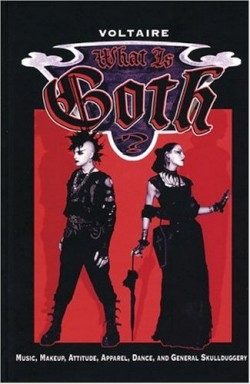What Is Goth?
Music, Makeup, Attitude, Apparel, Dance, and General Skullduggery
The planet, it appears, is ready for a brand new Voltaire. This one doesnt quite possess the philosophical power of the eighteenth-century French one, but he definitely has a witty, cockeyed viewpoint that the earlier Voltaire lacked. That viewpoint goes well with the subject matter that the new Voltaire adores exploring: the Goth culture, in all its faux-depressed, black-draped, raven-haired beauty.
Well known in the Goth community, as both a denizen and a commentator through works like the Oh My Goth! graphic novels, Voltaire now offers a guide to all things Goth. Its a kind of very dark primer for the Goth wannabe, but makes for a great read for everyone else. In it, the author sweeps away the stereotypes and shows that far from being misunderstood and troubled youths, many Goths simply like dressing up.
But its difficult to generalize even to this degree; as Voltaire shows so artfully, there are numerous variations on the Goth theme, from the punked-out “DeathRockers” with black mohawks and skull pendants, to the lovely “RomantiGoths” who don turn-of-the-century garb, lacy black gloves, and an air of haughty, dark aristocracy. Beyond identifying the Goth variations, Voltaire delves deep into the Goth philosophy and practices, sometimes giving a straightforward explanation of a belief system thats familiar to many a seemingly wayward teen. “We are expected to be persistently happy and are discouraged from expressing any discontent or loneliness,” he writes. “Just tell your mom that you were sad at school today and chances are that within the week you will be sent to therapy.”
In such an aggressively upbeat mainstream culture, some Goths rebel partially because they feel that this two-dimensional attitude is false, and denies a vital aspect of the human condition. Other Goths merely want to change the rules by which theyre judged. In a society that values athleticism, tanned skin, and blonde hair, becoming a pale, thin, dark-haired Goth is an antidote.
Voltaire balances these fascinating sociological explorations with winking, sly commentary on Goth habits, and mocks them with enormous affection. Particularly splendid are the illustrated “dance” steps that include routines like the “Cobweb in the Attic,” in which the dancer seems to reach up and pull cobwebs down from attic eaves. Also amusing is the “Gothic Poem Generator,” which looks like the classic car game MadLibs, in which the player fills in the blanks. In this case, the adjectives and nouns are predictably dark, with words like “lugubrious” and “succubae” as suggestions.
The effect of blending the serious and the witty in this book is charming, in a black-lipstick kind of way. This, after a thorough education from the new Voltaire, is a pretty cool way to be.
Reviewed by
Elizabeth Millard
Disclosure: This article is not an endorsement, but a review. The publisher of this book provided free copies of the book to have their book reviewed by a professional reviewer. No fee was paid by the publisher for this review. Foreword Reviews only recommends books that we love. Foreword Magazine, Inc. is disclosing this in accordance with the Federal Trade Commission’s 16 CFR, Part 255.

